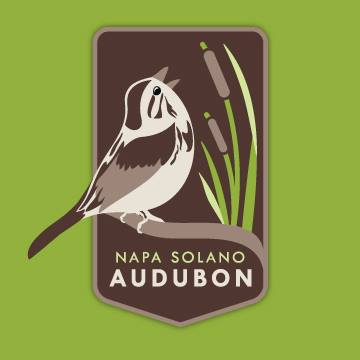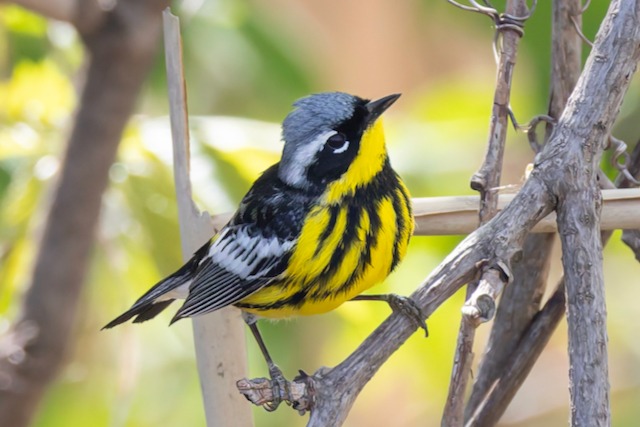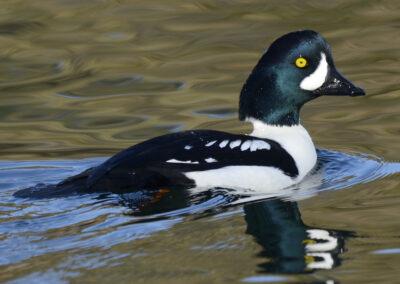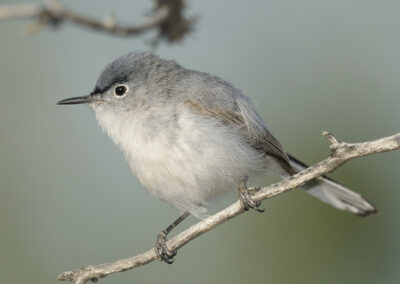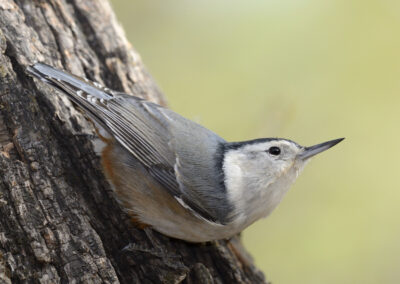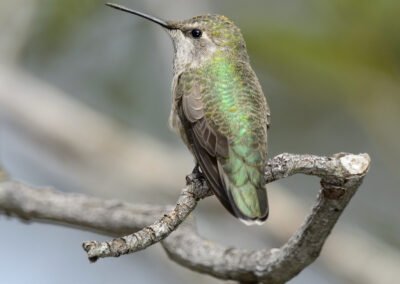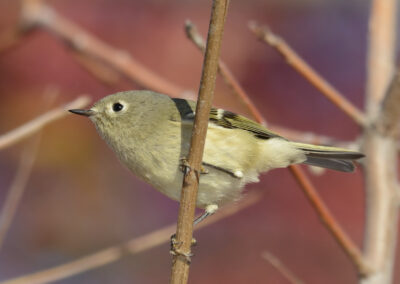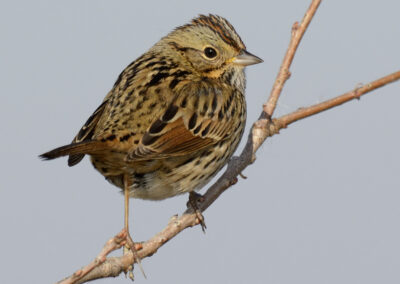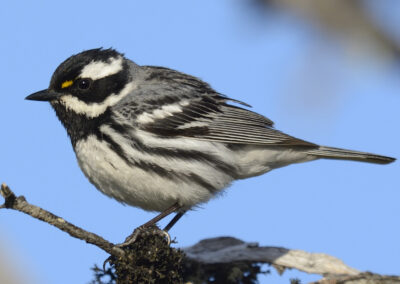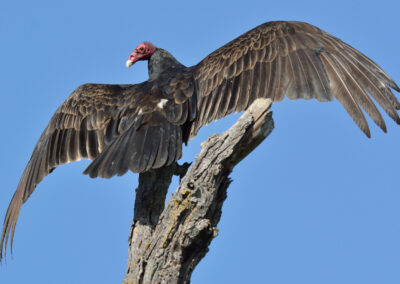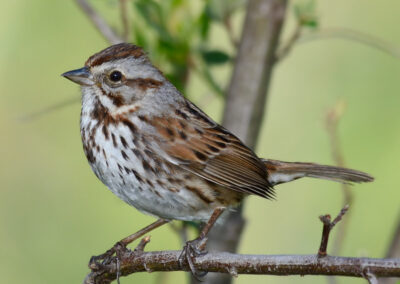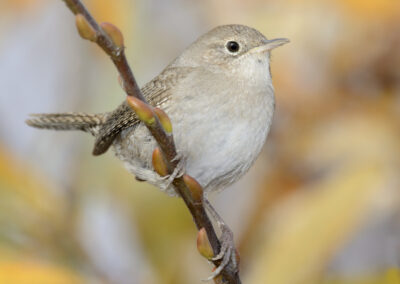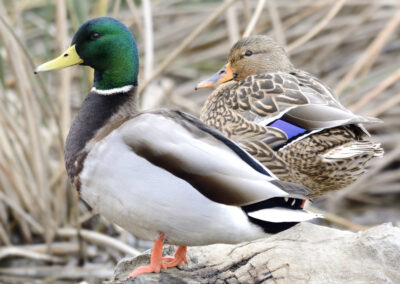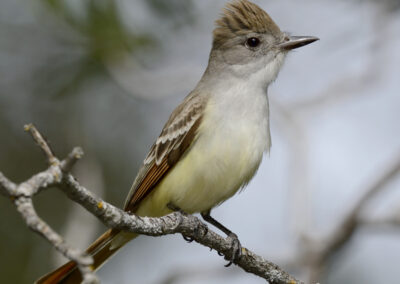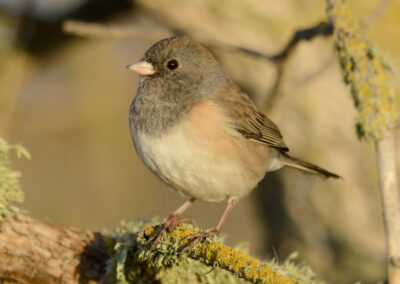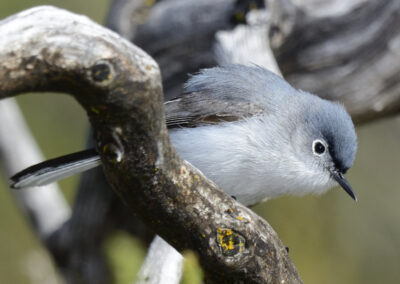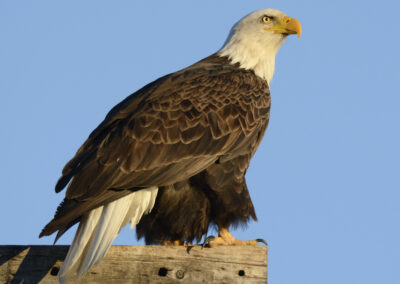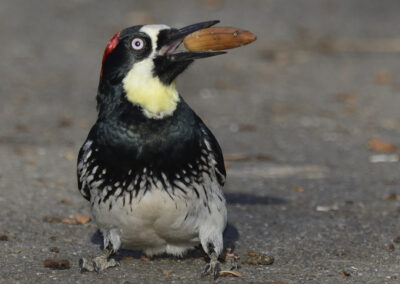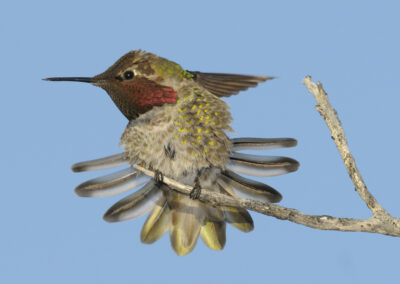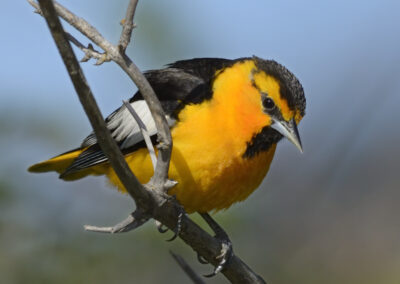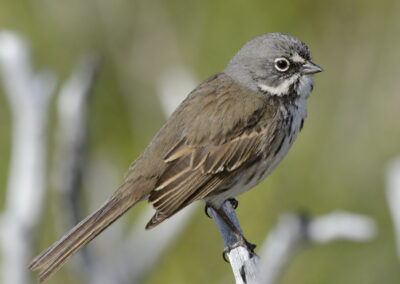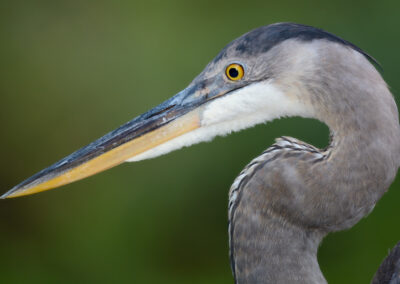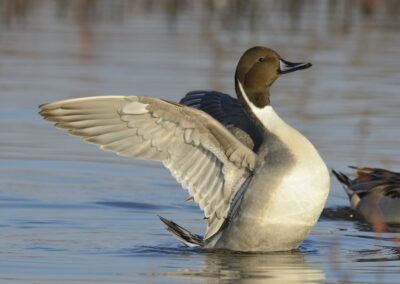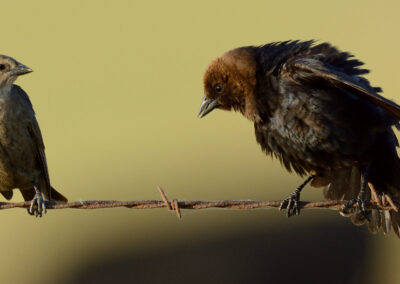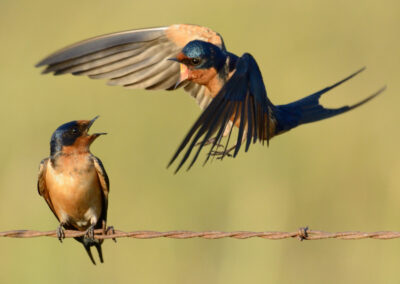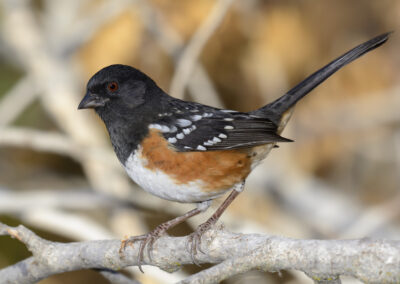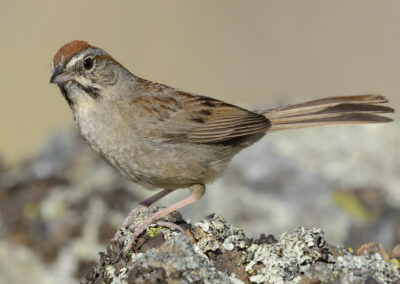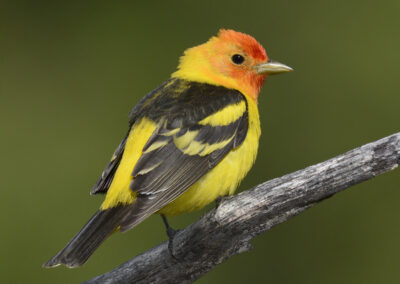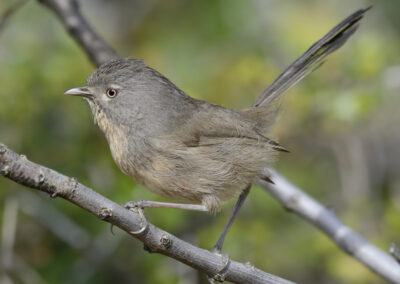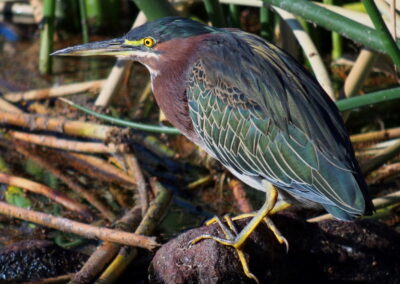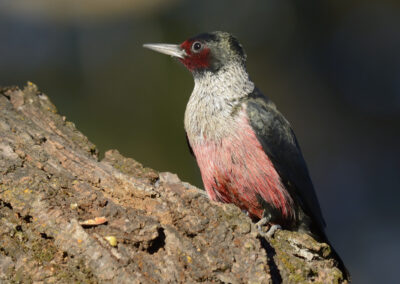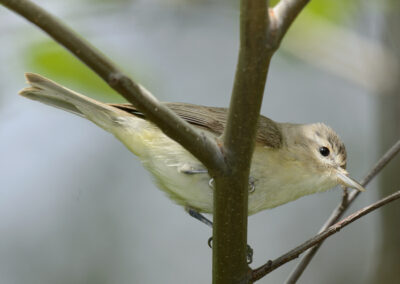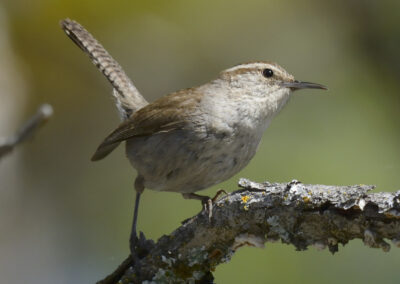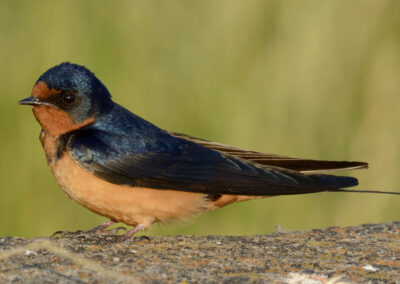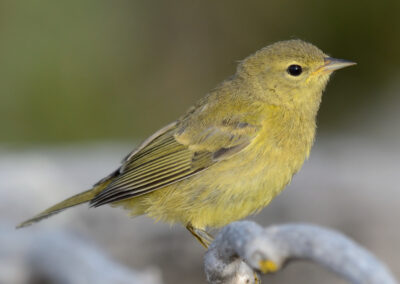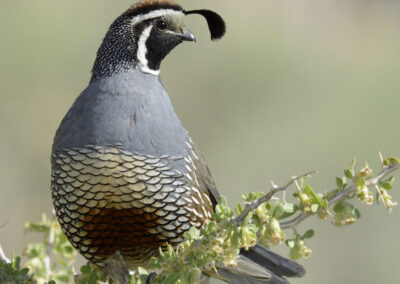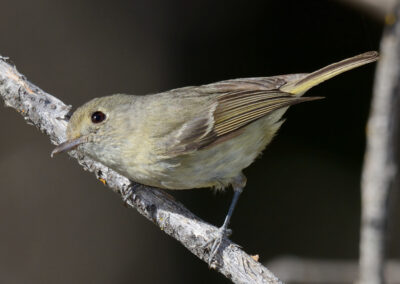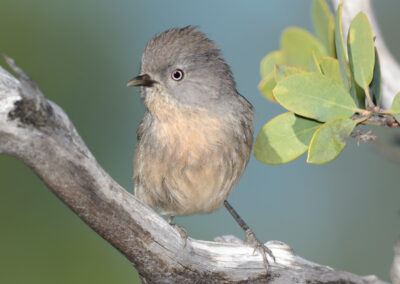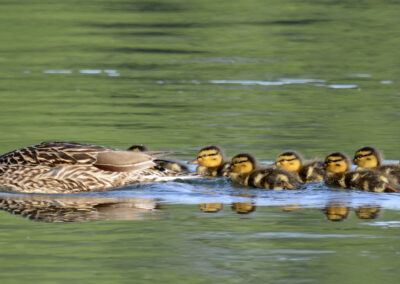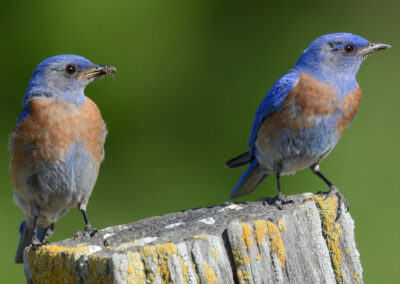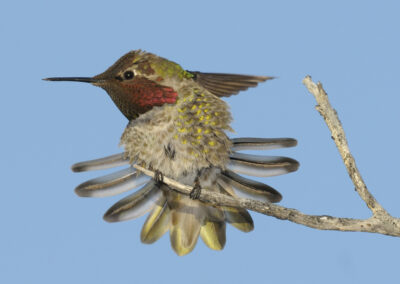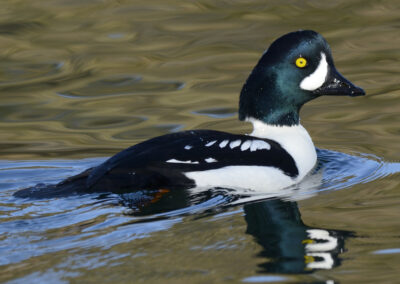Napa Solano Audubon Speaker Series Video Archive
October 9, 2025 NSAS Presents The Status of Purple Martins with Dan Airola

About the Presentation: The well-documented and drastic decline in the Purple Martin nesting population in Sacramento has contributed to concerns about the species’ status throughout California. The species has been recognized as a state Species of Special Concern for nearly 50 years. Dan Airola is co-leading a comprehensive statewide Purple Martin status assessment 2025. Dan will discuss the unique life history of this largest North American swallow, differences between the eastern and western subspecies, current threats they face. He’ll present an overview of the status and conservation issues facing the species in California. He will also provide preliminary results of the 2025 statewide Purple Martin breeding population survey
About the Presenter: Dan Airola is a Sacramento Wildlife Biologist and Ornithologist who has worked for over 45 years in research and conservation of at-risk bird species in Northern California. Dan has conducted research and a conservation program for the Sacramento Purple Martin population for over 30 years. He also has conducted several status assessments of the species in California and is co-leading the 2025 statewide status. Dan also has also led studies in Northern California for the Tricolored Blackbird, Yellow-billed Magpie, Osprey, Bald Eagle, Swainson’s Hawk, Turkey Vulture, fire-adapted forest species, migrant songbirds, and diving ducks. Dan also serves the Central Valley Bird Club as a Director, Conservation Chair, and editor of the journal Central Valley Birds and is a Conservation Committee member for Sacramento Audubon
Click here to find a link to: The Status and Conservation of Purple Martins in California
September 11, 2025 NSAS Presents: The Biggest Week in American Birding with Mark Stephenson
About the Program: The Biggest Week is one of the largest birding festivals in the U.S. held in early May just East of Toledo on the shores of Lake Erie. This annual Festival draws upwards of 10,000 birders from around the country. Northern Ohio is considered by some to be the “warbler capital of the world” as thousands of migrating warblers land on the shores of Lake Erie to refuel, before crossing this great expanse of water and continuing on their journey North. The heart of the festival happens at Black Swamp Bird Observatory’s Magee Marsh Board Walk, a 2.5 mile path through the shoreline marsh. Magee is unique in that the high water table keeps most trees at shortened heights, providing more exceptional views of our spring migrants. This, coupled with the fact that early May is when most trees are just beginning to bud, before leaves make viewing more challenging, is why the Biggest Week is so exciting. During this year’s 9-day festival at the Boardwalk, along with a number of local area hotspots, birders observed 243 species including 36 North American Warblers.
About the Presenter: Mark has been the President of our Chapter, Napa-Solano Audubon, for the past 5 years. He began birding in the 4th grade and his birding knowledge expanded dramatically when his family moved to Ithaca, NY where he birded regularly with his mentor, Dr. Arthur Allen, founder of Cornell’s Laboratory of Ornithology and other leading experts from the Lab. During college he worked summers at Sapsucker Wood’s and for the Massachusetts Audubon Society before heading west and directing Environmental Education Programs at Foresta Institute in Washoe Valley, Nevada. After a career of more than 30 years in public education in Benicia and Napa Valley schools, he is enjoying retirement. When Mark’s son, Lucas, caught the “Birding Bug,” Mark turned from his passion for portrait and landscape photography to focus on birds. With Lucas, he has traveled to every corner of California, Arizona, Texas, Ohio, Florida, and Costa Rica observing and photographing birds. This Spring, after previously attending the Biggest Week 8 years ago with Lucas, Mark returned to the festival with his brother Tom and our very own Tom Slyker and took hundreds of photos of Ohio’s migrants and resident birds. He is excited to share his experiences with our community and his friends from Napa-Solano Audubon.
Click here to find a link to: The Biggest Week in American Birding with Mark Stephenson
May 8, 2025 NSAS Presents: The Land Trust of Napa County with Mike Palladini

Screenshot
About the Program: The Land Trust of Napa County (LTNC) is a non-profit organization dedicated to land conservation and stewardship. In its 49-year history, LTNC has protected over 94,000 acres. Stewardship Director Mike Palladini will present an overview of LTNC’s Land Stewardship Program. He will highlight a broad range of conservation and restoration projects within the Land Trust’s 22,000-acre preserve network including restoration of meadow, oak woodland, riparian and forested habitats, post-fire avian and plant community monitoring, threatened species conservation and recovery, wildfire resilience, and wildlife camera monitoring.
About the Presenter: Mike Palladini has served as director of LTNC’s Land Stewardship Program for the last 14 years. He coordinates management of the Trust’s 22,000-acre preserve system, including projects related to habitat and watershed restoration, biological resources assessment and monitoring, applied conservation science research, wildfire and climate resilience, and public access and education. Mike has extensive experience in both land stewardship and field biology. Mike completed an M.S. program in Wildlife Biology at Humboldt State University in 2007, and spent eight years working on avian research and conservation projects for a number of organizations including the U.C. Santa Barbara Marine Science Institute, Point Blue Conservation Science, U.S. Forest Service Pacific Southwest Research Station and University of Montana Avian Science Center. Prior to joining the Land Trust, Mike served as Land Steward for a watershed conservation group in northwest Montana’s Swan River Valley where he assisted private landowners with development of conservation plans and implementation of restoration and management projects. Mike is also a long-time native bird enthusiast, enjoying birding adventures across the western U.S., Central and South America, Mexico, Australia and Southeast Asia.
Click here to find a link to: Land Trust of Napa County with Mike Palladini

April 10, 2025 NSAS Presents: Exploring Florida Birds with Mark Stephenson
About the Program: Mark hasn’t been birding back in Florida since he was a teenager in the 60’s with his brother Tom wading through swamps in search of Limpkins, Wood Storks and Flamingos. His family used to drive down from Ithaca, NY in their Rambler station wagon every couple of years on a vacation to visit his grandparents who lived in Brooksville, North of Tampa. During those years they convinced their parents to take them on birding excursions to visit the Everglades, Pine Island, Sanibel Island’s Ding Darling National Wildlife Refuge and as far South as they could travel down into the Keys. Those were the good old days with plenty of Spoonbills, Wood Storks and Limpkins to go around. During the last 2 years Mark has returned to bird Florida in April 2024 on the Atlantic side from Orlando to the tip of the Keys. He traveled their again over New Years 2025 on the Gulf side in the vicinity of Fort Myers. He visited a number of new exciting birding locations and photographed some of Florida’s most exciting birds! His presentation will take a look at some of the best birding locations that Florida has to offer as well as close-up looks at Florida’s many Herons, Terns, Shorebirds, Raptors, Woodpeckers, Warblers and other impressive Passerines.
About the Presenter: Mark has been the President of Napa-Solano Audubon for the past 5 years. He began birding in the 4th grade and his birding knowledge expanded dramatically when his family moved to Ithaca, NY and he birded regularly with Dr. Arthur Allen, founder of Cornell’s Laboratory of Ornithology and other leading experts from the Lab. After High School he worked summers at Sapsucker Wood’s and for the Massachusetts Audubon Society before heading west and directing Environmental Education Programs at Foresta Institute. After a career of more than 30 years in public education he is enjoying retirement and Northern California birding. Lucas, his youngest son, rekindled his excitement for birding after they went backpacking at Point Reyes. Mark turned from his passion for landscape photography to focus on birds. With Lucas, he has traveled to every corner of California, Arizona, Texas, Ohio, Florida, and Costa Rica searching for birds and taking their photos. So come over to the Benicia Public Library and enjoy his presentation of Florida’s amazing birds and learn about some of the best birding hotspots where you can locate them!
You will find a link to: Exploring Florida Birds with Mark Stephenson
March 13, 2025 NSAS Presents: Our Native American’s Reverent Relationship with Birds – with Charlie Toledo
About the Program: Birds played a significant role in Native American Cultures. Birds were used by every Native American tribe for food, medicine, art and ceremony. Ms. Charlie Toledo will share her knowledge of birds and the role they played in CA Native American cultures. She will explore the reverent relationship that CA Native American tribes had with these incredible feathered friends.
About the Presenter: Charlie Toledo is of Towa descendent, native to New Mexico. She is the Executive Director of the Suscol Intertribal Council, a community-based organization, since 1992 located in Napa, California. She has extensive experience as public speaker, presenter, and community organizer in regional, statewide, national and international forums. Since 1982 she has worked in alternative healthcare fields, as well as background in mediation for individuals, families, and organizations. She has been an organic gardener since 1978. She has lifelong commitment to social justice and international work on Human Rights and Environmental social justice issues.
You will find a link to: Our Native American’s Reverent Relationship with Birds with Charlie Toledo
February 9, 2025 NSAS Presents: Colombia Birding with John Sterling
About the Program: Colombia is one of the top birding destinations with over 1,900 species. John will give an overview of many of the top locations and rare and endemic birds from his recent tours. From Caribbean coast to pacific rainforest lowlands to the three ranges of the Andes and valleys in between and the Orinoco lowlands bordering Venezuela, he will illustrate the huge diversity with his photographs of fancy and exotic birds.
About the Presenter: John has been a hard core birder in California since he was shown a Pileated Woodpecker in 5th grade camp in 1971. He is a professional ornithologist and has worked for the Smithsonian Institution, US Forest Service research stations, HT Harvey & Associates, Arizona and Oregon state universities among other organizations since 1981. John has traveled extensively throughout California learning about local bird distribution and is an authority on that state’s avifauna. In 2015 he set the California’s new big year record with 501 species and has many big day records as well. He has traveled internationally as a guide and ornithologist for many institutions including projects as a Smithsonian ornithologist to Mexico, Ecuador, Peru, The Philippines, Sumatra, Canada and Russia.
John currently has his own company, Sterling Wildlife Biology (www.sterlingbirds.com), specializing in tours, birding classes, research and environmental consulting for The Nature Conservancy, the Kern Water Bank, the California Rice Commission, the Smithsonian Migratory Bird Center, National Audubon’s International Alliance Program, CA Dept. of Water Resources among other organizations.
You will find a link to: Colombia Birding with John Sterling
January 9, 2025 NSAS Presents: Badger Run Wildlife Rehab with Liz Burton
About the Program: Liz will be talking about how she got started in Wildlife Rehabilitation, her original vision for Badger Run Wildlife Rehab, what happened along the way and where they are now. She will also give “case studies” of some of their Educational Ambassadors from injured bird intake. She will be happy to answer any questions about Wildlife Rehab or Exotic Rescue at the conclusion of her talk.
About the Presenter: Liz Burton is the Founder and Animal Care Manager of Badger Run Wildlife Rehab in Keno, OR. She has been devoted to wildlife rehabilitation for almost 50 years, ever since she was 16 when she discovered that most veterinarians won’t touch wildlife and how much injured creatures need advocates and caregivers. Liz holds a B.S. degree in Animal Ecology, Behavior and Evolution; training which she uses to help keep the wildlife in Badger Run Wildlife Rehab’s care comfortable and in good health both physically and mentally. She is also active in exotic pet rescue and educating exotic owners in the proper selection, husbandry and care of their animals.
You will find a link to: Badger Run Wildlife Rehab with Liz Burton Video Link
November 14, 2024 NSAS Presents: The Raptor Advantage with Dr. Craig Farquhar
About the Program: Learn about ‘the raptor advantage’ with this brief overview of what a ‘raptor’ really is; focusing on the main anatomical and physiological adaptations that are featured in these birds which are products of millions of years of evolution honing virtually every body part to a lifestyle that depends on being able to capture prey that would rather not be devoured.
About the Presenter: Dr. Craig Farquhar is a conservation biologist, raptor ecologist, and illustrator, formerly with the Texas Parks and Wildlife Department (TPWD), Austin, TX (retired 2018), currently teaching Raptor Ecology and Ecology of Rarity at Texas State University, San Marcos, TX. He received a PhD in Raptor Ecology and Wildlife Biology at Texas A&M University, College Station, TX, later a Frank M. Chapman postdoctoral fellowship in the Department of Ornithology at the American Museum of Natural History, New York studying raptors in South America. He, along with co-author, Dr. Clint Boal published Raptors of Texas, in 2022.
You will find a link to: The Raptor Advantage with Dr. Craig Farquhar Video Link
October 10, 2024 NSAS Presents: A Bit About Bats with Corky Quirk
Bats play an important role in the ecosystem as major consumers of nocturnal insects. They have many adaptations to help them navigate the night sky, from flight to echolocation. Meet the fastest mammal on earth, the Mexican free-tailed bat and the new California State symbol, the Pallid bat. In her presentation, Corky will share her knowledge about California bats along with a close up and personal experience of live, local, native species of bats. This is a great presentation to come to in-person for close up views of Ms. Quirk’s live Bats!
About the Presenter: Mary Jean (Corky) Quirk, Founder NorCal Bats Corky Quirk is the founder of NorCal Bats, an organization that provides care for injured bats and educational programs for libraries, schools, nature programs, fairs and other community events throughout the region. Corky has been working intensely with native bats since 2004 and has educated thousands of people of the important role they play in our ecosystems. She works with injured and orphaned bats, returning them to the wild and keeps a captive colony of non-releasable bats for use in education. Corky is the Director of www.norcalbats.org and is permitted through the CA Department of Fish and Wildlife and the USDA to support their conservation work with bats. Corky is an experienced environmental educator who got her start with Camp Fire Girls & Boys. She has an undergraduate degree in natural resource planning and interpretation from Humboldt State University. In addition to her work with bats, she teaches three days a week at the Yolo Basin Foundation, a wetland education program in the Sacramento Valley.
You will find a link to: A Bit About Bats with Corky Quirk at: Video Link
September 12, 2024 NSAS Presents:The Albatross of Kaua’i with Hob Osterlund
Hob Osterlund will kick off our Fall programs by speaking on the Albatross of Kaua’i: their Style and Story. Hob is a Safina Center Fellow and the founder of the Kauaʻi Albatross Network. She lives on Kauai and has helped to protect the Laysan Albatross and preserve their nesting habitat. She can often be found near the Kilauea Lighthouse hoping visitors to observe these exciting birds of the sea!
About the Presenter: Hob Osterlund is the author of “Holy Mōlī: Albatross and Other Ancestors” (Oregon State University Press, 2016 now in its fourth printing). In 2018 she produced a documentary called “Kalama’s Journey”, which won a Telly Award. An advanced-practice nurse who spent her career working in acute hospitals on Kauaʻi and Oʻahu, Hob performed a multi-ethnic pidgin-speaking comedy character called Ivy Push RN for national audiences. She now focuses her full time attention on advocacy for birds of Hawai’i, especially the magnificent Laysan Albatross. She is an engaging and entertaining speaker, so don’t miss out on this exciting presentation.
You will find a link to: The Albatross of Kaua’i at: Video Link
May 9, 2024 NSAS Presents: Birding in the Northern Sierras from the Valley Floor to the Sierra Crest with Denise & David Hamilton and Lucas & Mark Stephenson.
Have you ever visited the Sierras and wondered where to go to find the most exciting birds? The Hamiltons and Stephensons have teamed together to share their 20 years of experience birding in the Northern Sierras from the Sierra Valley to the Sierra Crest, and locations further North. They will show you their best photos of the birds, plants & wildlife they have observed exploring Sierra ecosystems from Marble Hotsprings on the valley floor, to unknown canyons around the perimeter, to the top of the Sierra Crest. They will take you to explore a number of places that you have likely never visited before. Their travels will include favorite birding locations along Highways 49 & 89 from Bassett’s, Sardine Lakes, & Yuba Pass to untraveled forest service roads. They will share birding hotspots above Graeagle, from the Graeagle Lodge and Lakes Loop Trails, to Church Meadows and Mills Peak. For those curious of locations further North, they will explore spots near Lake Davis, Smith Peak & Bagley Pass. As an added bonus they will venture to a few locations in the high Eastern Desert including Frenchman Lake, Red Peak Pass and Shaffer Mountain. Come join us to see the flora and fauna they have observed during their years of exploring these birding jewels of the Sierra! For detailed information on the location of birding sites described in this presentation, click here
About the Presenters: David and Denise Hamilton are members of Napa-Solano Audubon and have been birders for the past 42 years. Both grew up in southern California; Denise enjoyed birds from the start, but David didn’t catch the bug until they got married in 1980 and moved to Minnesota. David finished school there, and Denise finally got to see her first Northern Cardinal. Then they saw an Indigo Bunting followed by a Baltimore Oriole, and were hooked! They spent the next five years on the northern prairies of Montana, living with birds that many still have on their “want-to-see list”; this really helped spark their passion. Since then, they’ve travelled around the USA, Costa Rica, Trinidad & Tobago, Panama, Romania, Australia (twice), South Africa, and Ecuador. Their Napa backyard bird list for the past 22 years is at 142 species, including 6 species of hummingbirds, 10 species of warblers, Evening Grosbeaks, and some amazing sparrows such as Clay-colored and Black-throated (a new bird for Napa County in 2021.)
The Stephensons are well known to NSAS. Mark has been the President for the past 4 years and Lucas has grown into an amazing birder finding all kinds of rare birds in the Bay Area. Mark began birding in the 4th grade and expanded his experiences when his family moved to Ithaca, NY and he birded regularly with Dr. Arthur Allen and experts from Cornell’s Laboratory of Ornithology. After High School he worked summers at Sapsucker Wood’s and for Massachusetts Audubon before heading west and directing Environmental Education Summer Camps and Expedition Programs. After a career of more than 30 years in public education, teaching and administrating in Benicia and Napa, he is enjoying retirement and Northern California birding. Lucas is a senior in High School and has been birding since he was 8, when he got the “Birding Bug” hearing a Great Horned Owl calling outside his tent while backpacking at Point Reyes. He was completely hooked after observing his first Varied Thrush. Now, with his growing expertise he helps his Dad locate and photograph those challenging and “hard to find” birds. He is headed to Cal Poly Humboldt in the Fall where he will be majoring in Wildlife Biology.
You will find a link to: Birding in the Northern Sierras from the Valley Floor to the Sierra Crest at: Video Link
April 18, 2024 NSAS Presents: In Search of the Great Gray Owl with Harry Fuller
The Great Gray Owl is the tallest owl in North America and will be our top priority. There are more Great Gray Owls in Jackson County than all of California. May is the height of their nesting season so the male is often hunting in daytime, while his mate is on the nest. There are several locations east of Ashland where this species usually nests each year, and we hope to observe one or more on our May Field Trip.
About the Presenter: Harry Fuller. Harry used to live in San Francisco and was a founding member of San Francisco Field Ornithologists. He taught ornithology classes and led numerous birding trips in the area. Harry now lives in Oregon and is active in the birding community, and leads trips in that area. He is the author of The Great Gray Owls of California, Oregon and Washington, and Freeway Birding, San Francisco to Seattle.
You will find a link to: In Search of the Great Gray Owl with Harry Fuller at: Video Link
April 11, 2024 NSAS Presents: Why Birds Flock with Jessica Griffiths
About the Presentation: You may have heard the old saying that birds of a feather flock together. But have you ever stopped to wonder why? Join Jessica Griffiths for a fascinating look at bird flocks and flocking behavior. Why do some species of birds form flocks, while others do not? Why do geese and ducks fly in a “V” formation? How do birds flying in large flocks synchronize their movements? Learn the answers to these questions and more in this presentation, which touches on bird biology and behavior, and highlights some remarkable scientific discoveries.
About the Presenter: Jessica Griffiths has worked as a wildlife biologist in California for 20 years, focusing on songbirds and monarch butterflies. She loves birding, and enjoys sharing her passion for birds and conservation via bird walks and public talks. She currently works as a wildlife biologist for Colorado State University’s Center for Environmental Management of Military Lands (CEMML) at Vandenberg Space Force Base.
You will find a link to: Why Bird Flock with Jessica Griffiths at: Video Link
March 14, 2024 NSAS Presents: The California Bluebird Recovery Program with Mike Azevedo & Georgette Howington
About the Presentation: The Western Bluebird is an iconic bird, one of our favorite bird species, featured in Disney movies and modern culture. Back in 1971, the Western Bluebird was living on land owned by a man named Don Yoder. Don was building a house. Trees were cut to make room. Sadly, the trees contained a bluebird nests. It didn’t seem fair. Don was getting a brand new home, but the bluebirds were left with nothing. Don took action and created The California Bluebird Recovery Program to promote the use of nest boxes for bluebirds and other cavity nesting species. Join Mike Azevedo and Georgette Howington of the California Bluebird Recovery Program to learn about cavity nesting birds in our backyard and what we can do to help them. We’ll find out why they are important and beneficial to humans and what will make our nest boxes successful.
About the Presenters: Mike Azevedo has been the Santa Clara County Coordinator for the California Bluebird Recovery Program since 2009. Mike has been a Science Camp naturalist, park ranger and merit badge counselor for nature related merit badges for years. Mike is compiler of the San Jose Audubon Christmas Bird Count and has worked with Santa Clara Audubon Society closely since becoming involved. Mike is working with Sequoia Audubon Society on a project to save the Western Purple Martin, a species of special concern that is battling habitat loss, deadly competition with the introduced European starling and food source crash due to the rampant use of neonicotinoid pesticides. Together with Georgette Howington, Mike is an editor of the CBRP Facebook Page and is currently working on books and videos encouraging the use of native plants, nest boxes and habitat improvement in general.
Georgette Howington is a Life Member of California Garden Clubs, a certified Horticulturist and UC Davis Naturalist of the Mt. Diablo Region. Her affiliations as a conservationist in the SF Bay Area community for over 30 years include membership in Mt. Diablo Audubon Society and the California Bluebird Recovery Program (www.cbrp.org) among others. Georgette is State Assistant Program Director of CBRP and has been a nest box monitor for 25 nesting seasons. Her specialized niche is the study and conservation of cavity nesters and their associated habitats. Georgette sponsors Eagle Scout candidates, Girl Scouts, and mentors’ students. She represents CBRP and stages exhibits at local community events, offers educational workshops and community presentations. Georgette is also an avid gardener, published writer and poet. She and her husband live in Rossmoor, Walnut Creek, with their two indoor cats.
You will find a link to: The California Bluebird Recovery Program at: Video Link
February 8, 2024 NSAS Presents: The Internet of Wings: How the Data Revolution Is About to Change the Way You Bird with Nathan Pieplow
About the Presentation: What if your phone could pick out rarities for you from a flock of birds? What if it could tell you exactly where an individual migrant came from and where it is going? These technologies already exist, or soon will. In this talk, Nathan Pieplow will discuss how cutting-edge innovations in bird tracking and automatic identification can enhance conservation, supercharge citizen science, and broaden the appeal of birding. You’ll learn how the song of a White-crowned Sparrow communicates not just its species identity, but its street address. You’ll learn what happened when a flock of curlews ran into a snowstorm, and how we know. And you’ll learn how YOU can collect the data needed to reverse declines in bird populations.
About the Presenter: Growing up in South Dakota, Nathan got started identifying bird songs by studying the classic “Birding By Ear” field guides in the Peterson series. It wasn’t until 2003, when he faced the frustrations of studying sounds for his first trips to Mexico and Costa Rica, that he became dedicated to finding new and better ways to learn, describe, and catalog bird sounds. Along the way he became a sound recordist and an amateur ethologist (a student of animal behavior). He’s not one of those superhuman beings who can identify every singing bird, or discern the nocturnal flight call of a Blackpoll Warbler as it passes overhead in the dark. His high-frequency hearing is getting worse every year, and I don’t have a great auditory memory. To learn bird sounds, he wanted more resources: more recordings, better glossaries, deeper discussions. So he set out to create his own resources. These pages are part of the result. The Peterson Field Guide to Bird Sounds is another part. Nathan lives in Boulder, Colorado, where he teaches writing and rhetoric at the University of Colorado. He was a former editor of the quarterly journal Colorado Birds and one of the developers of the Colorado County Birding Website and the Colorado Birding Trail. He regularly gives talks about bird sounds to bird clubs and ornithological societies.
You will find a link to: The Internet of Wings with Nathan Pieplow at: Video Link
January 11, 2024 NSAS Presents: A Tour of Sri Lanka Wildlife, Focused on Birds with John Glover
Join us on a tour around Sri Lanka where we will visit all the habitats this beautiful country has to offer, from the costal salt marshes, inland to the extensive rice paddies, tea plantations, up into the central highlands and back to the coast. We will visit the largest National Parks and see the diverse wildlife as we focus on birdlife. On the tour John traveled mostly by bus, but also by 4-wheel drive vehicles to get to his birding destinations. The tour consisted primarily of birders from England, so a retuning of English was needed to understand all the participants. Over the course of 18 days, we observed 261 species, including 30 endemics. We also saw a variety of mammals, reptiles, and insects.
Meet the Presenter: John Glover’s interest in birds started in grade school, exploring the cow pastures and creeks around Palo Alto. His love of nature continued to grow as a boy scout working on merit badges on the way to becoming an Eagle Scout. It evolved into an undergraduate degree from the University of Michigan in Natural History Interpretation, but the paucity of jobs led to a refocus on teaching a variety of biology subjects at several universities. A back injury caused him to change directions and enroll in osteopathic medical school and training as a Family Physician. When the opportunity to teach presented itself John set his focus to teaching medical students and ended up back in California at Touro University on Mare Island where he still helps from time to time after retirement. John has had the pleasure of birding in all the continents and many countries. He has served on the NSAS board as Vice President for several years and combines his love of photography with birding and the adventure of world travel.
You will find a link to: A Tour of Sri Lanka Wildlife, Focused on Birds with John Glover at: Video Link
November 9, 2023 NSAS Presents: Raptor Quest with Scott Harris
Scott Harris spent 17 months, chasing 53 Raptors across 34 states—his version of a Raptor Big Year. RaptorQuest is about his adventures, misadventures, successes and failures. From -36 degree days, to ones over 100 degrees, to just getting on the bird just in time, to the frustrations of missing one by minutes. It’s about the birds—of course—but it’s also about the people he met, the things he learned, and why he’s already working on his next adventure.
Meet the Presenter: Scott Harris and his wife Randi retired to South Carolina in March of 2020, something Scott will tell you was one of the best decisions they have made in their 44 years of marriage. It was also when he first started birding – a hobby he never imagined himself participating in, but now can’t imagine living without. They sold their long-time home and business, Mustang Marketing, a marketing/branding company they had owned for 35 years. While in California, Scott had a syndicated newspaper column and two weekly radio shows. He and his son Justin also hosted a Los Angeles Dodgers weekly live radio show. Scott sat on dozens of boards over the years, including Boys & Girls Club, United Way, The Sheriff’s Foundation, Pepperdine University, Moorpark College, and California State University Northridge. In the month before leaving Ventura County, Scott was honored as Man of the Year, with his company having won Business of the Year two years previously. His interests and hobbies include the largest collection of John Steinbeck’s Travels with Charley in the world, playing harmonica in a blues band for five years, and he has written almost fifty books in the past six years – though the one he’ll be discussing today is his first entrée into the world of birding and birds. RaptorQuest: Chasing America’s Raptors, is the story of his year-long adventure tracking down every species of Raptor in the Lower 48!.
You will find a link to: Raptor Quest with Scott Harris at: Video Link
October 12, 2023 NSAS Presents: Biking for Birds with Dorian Anderson
On January 1st, 2014, Dorian Anderson boarded his bicycle for what would prove the adventure of a lifetime. His two-wheeled permutation was an eco-friendly twist on the Big Year classic, a year-long project during which a birdwatcher tries to observe as many species as possible. While his predecessors utilized cars, planes, boats, and even helicopters, Anderson’s goal was to replicate their transcontinental efforts without the use of petroleum, a herculean challenge no one before him had accepted. He ultimately survived subzero temperatures, many feet of snow, gusting winds, lightning storms, mountainous ascents, dog attacks, crumbling roads, and accidents of various sorts in the process of amassing 18,000 miles and 618 species, totals no one imagined possible when he departed Massachusetts without an ounce of relevant cycling experience. Anderson will speak about the genesis of his bike-birding project, provide a thrilling recount of his travels, highlight the birds he saw, and reveal how his adventure changed his life. His personality and enthusiasm are infectious, and his tales of birding, cycling, and self-discovery will inspire others to venture into the outdoors and take note of the birds around them.
Meet the Presenter: Dorian Anderson started birding in his backyard in Philadelphia at age seven. His interest grew to include the Delaware Valley and Jersey Shore during his preteen years, and he attended several of Victor Emanuel’s youth birding camps as a teenager. He envisioned himself a life-long birder until his educational rise and coincident alcoholism extinguished his birding desire. With his focus split between science and drinking, his passion for birding atrophied through his twenties, until he got sober at thirty and reconnected with his former obsession. Despite the aforementioned alcoholism and much coincident drug use, Anderson received his B.S. in Biochemistry and Molecular Biology from Stanford University, did predoctoral research at Harvard University, and earned his Ph.D. in Developmental Genetics and Molecular Cell Biology from New York University. After getting sober and moving to Boston, he spent three years as a Postdoctoral Fellow in Molecular Neuroscience at Massachusetts General Hospital before resigning the academic rat race and undertaking his Bicycle Big Year. Momentum from that life-changing project opened many doors including public speaking and travel writing. Anderson worked in Colombia as a consultant for the National Audubon Society, and he is currently a guide for Tropical Birding. He is an accomplished bird photographer and has just finished his long-awaited memoir, Birding Under the Influence: Cycling across America in Search of Birds and Recovery. Pre-orders are now being accepted ahead of a November 2 release date. You can find his book at: https://www.amazon.com/Birding-Under-Influence-Cycling-Recovery/dp/1645022234
You will find a link to: Biking for Birds with Dorian Anderson at: Vidoe Link
September 14, 2023 NSAS Presents: An African Safari with David & Denise Hamilton
In September of 2017, David & Denise visited South Africa with Rockjumper Birding Tours, a SA-based eco-tour company. This was a two-and-a-half week tour covering the world-famous Kruger National Park, Sani Pass, Cape Town, and places in between. It was an adventure just getting to Africa, but once there the real adventure began! We birded from the ocean shores (Atlantic and Indian) up to 9,436 ft at the top of Sani Pass, and spent part of one day in the independent mountain-kingdom of Lesotho (Hamilton Lesotho life-list = 14 species). Both Denise and David sighted their 2,000 world birds during the trip on consecutive days (ladies first.) The trip ended with a visit to the Tankwa Karoo, a unique semi-desert natural region east of Cape Town, and a trip list of 439 birds and more than 60 other animal species. At the September meeting, the Hamiltons will share some of their stories and pictures from this amazing adventure!
Meet the Presenters: David and Denise Hamilton are members of Napa-Solano Audubon and have been birders for the past 42 years. Both grew up in southern California; Denise enjoyed birds from the start, but David didn’t catch the bug until they got married in 1980 and moved to Minnesota. David finished school there, and Denise finally got to see her first Northern Cardinal. Then they saw an Indigo Bunting followed by a Baltimore Oriole, and were hooked! They spent the next five years on the northern prairies of Montana, living with birds that many still have on their “want-to-see list”; this really helped spark their passion. Since then, they’ve travelled around the USA, Costa Rica, Trinidad & Tobago, Panama, Romania, Australia (twice), South Africa, and Ecuador. Their Napa backyard bird list for the past 22 years is at 142 species, including 6 species of hummingbirds, 10 species of warblers, Evening Grosbeaks, and some amazing sparrows such as Clay-colored and Black-throated (a new bird for Napa County in 2021.)
You will find a link to: An African Safari with David & Denise Hamilton at: Video Link
May 11, 2023 NSAS Presents: Spring Birding in Texas with Mark & Lucas Stephenson
Last year, Lucas and I decided to take on the challenge of birding in Southern Texas for his Spring vacation, in a state he had never visited before. We were delighted to learn that, Connor, one of Lucas’ best Young Birder friends, could join us with his grandfather for most of our expedition. Lucas and Connor spent hours researching many of the best southern Texas birding locations. We were off, flying into Houston and traveling to incredible birding meccas from the Southeast Coast along the Louisiana border, to Corpus Christi on the Gulf Coast, to the Southern Rio Grande, and inland as far North as San Antonio in search of birds that we had never seen before and the colorful spring migrants passing through the Texas Spring landscape. We will share some of the favorite birding hot spots that we visited including Sabine Woods, Anahuac NWR, High Island, Bolivar Flats NWR, Corus Christi’s Rose Hill Cemetery, South Padre Island, Bentsen-Rio Grande State Park, Salineno Wildlife Preserve, Lost Maples State Natural Preserve, and W.G. Jones State Forest. We will take you on our journey and show some of our best photos of many of the 285 species we observed on our 10 day trip (including nearly 50 life birds).
About the Presenters: Mark is our President of Napa-Solano Audubon and has been birding since his youth when he grew up in Ithaca, NY and was mentored by Dr. Arthur Allen, founder of Cornell’s Laboratory of Ornithology. Lucas his 17 year old son, has been birding since he was 8 years old and has perfected and superseded most of his dad’s skills and become a talented birder!
You will find a link to: Spring Birding in Texas with Mark & Lucas Stephenson at: Video Link
April 13, 2023 NSAS Presents: An Expedition to Antarctica with Robin Leong.
In 2008-2009 Robin Leong, our NSAS Past President and Board Member since 1981, took a 20 day trip to Antarctica on a Quark’s Explorer Tour. His presentation will give you an idea of what a trip to those environs is like in case visiting Antarctica might be on your bucket list. He will share photos of birds taken by trip members and a video that helps you to share in his experiences of this trip. The video, made by Quark, contains some of the best photos shared by the trip’s 85 participants. If you attend in person, Robin will share bird lists and other fun details about the trip. Don’t miss out on this exciting presentation from Robin’s Antarctica trip.
About the Presenter: Robin was born and raised in Hawaii. After graduating from the University of Hawaii and completing graduate work at UC Berkeley’s Department of Environmental Engineering he served as a Mechanical Engineer at Hunter’s Point and Mare Island Naval Shipyards. He has been birding since 1978 and has a life list exceeding 6,600 birds. Robin has served on the Boards of the ABA (American Bird Association) and Point Reyes Bird Observatory (now known as Point Blue Conservation Science), and as a Commissioner for Solano County Parks and Recreation. He is the co-author of many publications including, Breeding Birds of Napa County, Breeding Birds of Solano County, and numerous other publications.
You will find a link to: An Expedition to Antarctica at: Video Link
March 9, 2023 NSAS Presents: The Identification of Tricky Female Ducks with Lisa Hug
Ducks are amazing birds. We can usually identify the male ducks (or drakes) pretty easily with a bit of experience. However, the female ducks (hens) all seem to look alike. Many of us just ignore the females, but learning to tell them apart is a fun challenge. Lisa Hug will present a ZOOM tutorial on how to identify the females (Don’t worry, photos of the males will also be there). Please join the Napa-Solano Audubon Society for this exciting presentation.
About the Presenter: Lisa Hug is a birder and naturalist living in Sonoma County, California. She is very familiar with the birdlife (and other wildlife) of California. Her specialty area is the North Bay Area, which includes Marin and Sonoma Counties, highlighting Point Reyes National Seashore and Bodega Bay. Lisa is a freelance naturalist and contract biologist. She has been an Interpretive Ranger for Point Reyes National Seashore, a research assistant with Point Reyes Bird Observatory, and a naturalist on NOAA Research Vessels and for the Gulf of the Farallones National Marine Sanctuary. Lisa served as President of Redwood Regional Ornithological Society for several years and enjoys teaching birding classes in both Sonoma and Marin Counties.
You will find a link to: The Identification of Tricky Female Ducks with Lisa Hug at: Video Link
February 16th, 2023 NSAS Co-Presents with Golden Gate Audubon and other Bay Area Audubon Chapters: A World on the Wing with Scott Weidensaul.
Scientists continue to make astounding discoveries about the navigational and physiological feats that enable migratory birds to cross immense oceans or fly above the highest mountains, go weeks without sleep or remain in unbroken flight for months at a stretch. Scott Weidensaul, author of A World on the Wing(2021), takes us around the globe — with researchers in the lab probing the limits of what migrating birds can do, to the shores of the Yellow Sea in China, the remote mountains of northeastern India where tribal villages saved the greatest gathering of falcons on the planet, and the Mediterranean, where activists and police are battling bird poachers — to learn how people are fighting to understand and save the world’s great bird migrations.
About the Presenter: Scott Weidensaul’s field research focuses on bird migration. He is a co-director of Project Owlnet, a collaborative effort among over 100 banding and research stations across North America studying owl migration. Weidensaul co-founded Project SNOWstorm, which uses cutting-edge tracking technology to study Snowy Owls, and is a founder of the Critical Connections project, which is tracking the migration of birds that breed on National Park lands in Alaska. He is also part of a continental effort to understand the rapid evolution, by several species of western hummingbirds, of a new migratory route and wintering range in the East. He co-founded the Northeast Motus Collaboration, which is creating a network of nearly 150 automated telemetry receivers across the mid-Atlantic region and New England to track the movements of bats, insects and small birds.
The Link to: A World on the Wing with Scott Weidensaul is only available for the next 3 weeks at: Video Link
February 9, 2023 NSAS Presents: A Birdie Big Year – Elevating Women Birders with Tiffany Kersten
Tiffany Kersten didn’t set out to do a big year, but after a series of unanticipated and serendipitous events, she suddenly found herself amidst one. As a sexual assault survivor, she spent 2021 traveling to all corners of the Lower 48 States, tallying birds and gifting personal safety alarms to women she met along the way. Her goal was to see 700 species, and to raise awareness of women’s safety in the outdoors. Tiffany ended up surpassing her goal and setting a new Lower 48 Big Year record of 726. In her presentation, Tiffany will lead us through the fear, empowerment, struggles and healing that all played vital roles in the personal growth she experienced on this wild adventure.
About the Presenter: Tiffany Kersten is a Wisconsin native, turned Texan by way of New Jersey, Massachusetts, and Hawaii. She holds a B.S. in Wildlife Ecology from Northland College, and has spent over a decade as an environmental educator, teaching about raptor identification and migration with the Cape May Bird Observatory, monitoring shorebirds on Cape Cod, banding Honeycreepers in Hawaii, and finally landing in South Texas where she worked at Santa Ana National Wildlife Refuge, then Quinta Mazatlan World Birding Center, and managed the McAllen Nature Center, before founding her own company, Nature Ninja Birding Tours.
You may find a link to: A Birdie Big Year – Elevating Women Birders at: Video Link
January 12, 2023 NSAS Presents Birds of Morocco with John Sterling
John will share highlights from his tours’ adventures in Morocco. With its high mountains, high desert, low Sahara desert, agricultural plains, coastal lagoons, cork oak woodland, and coniferous forest, Morocco has much to offer to birds and birders. Home to several endemic bird species as well as North Africa species not readily seen elsewhere, it is also along the major migratory pathway for European migrants including shorebirds, raptors, songbirds and others. Join us for virtual tour of the country’s birds, landscapes and culture.
About the Presenter: John has been a hard core birder in California since he was shown a Pileated Woodpecker in 5th grade camp in 1971. He is a professional ornithologist and has worked for the Smithsonian Institution, US Forest Service research stations, HT Harvey & Associates, Arizona and Oregon state universities among other organizations since 1981. John has traveled extensively throughout California learning about local bird distribution and is an authority on that state’s avifauna. In 2015 he set the California’s new big year record with 501 species and has many big day records as well. He has traveled internationally as a guide and ornithologist for many institutions including projects as a Smithsonian ornithologist to Mexico, Ecuador, Peru, The Philippines, Sumatra, Canada and Russia.
John currently has his own company, Sterling Wildlife Biology (www.sterlingbirds.com), specializing in tours, birding classes, research and environmental consulting for The Nature Conservancy, the Kern Water Bank, the California Rice Commission, the Smithsonian Migratory Bird Center, National Audubon’s International Alliance Program, CA Dept. of Water Resources among other organizations.
You may find a link to Birds of Morocco at: Video Link
January 11, 2023 NSAS Presents: Nature’s Best Hope with Doug Tallamy !!!
Recent headlines about global insect declines and three billion fewer birds in North America are a bleak reality check about how ineffective our current landscape designs have been at sustaining the plants and animals that sustain us. To create landscapes that enhance local ecosystems rather than degrade them, we must 1 remove the invasives on our property and 2) add the native plant communities that sustain food webs, sequester carbon, maintain diverse native bee communities, and manage our watersheds. If we do this in half of the area now in lawn, we can create Homegrown National Park, a 20 million acre network of viable habitats that will provide vital corridors connecting the few natural areas that remain. This approach to conservation empowers everyone to play a significant role in the future of the natural world.
About our Presenter: Doug Tallamy is the T. A. Baker Professor of Agriculture in the Department of Entomology and Wildlife Ecology at the University of Delaware, where he has authored 106 research publications and has taught insect related courses for 41 years. Chief among his research goals is to better understand the many ways insects interact with plants and how such interactions determine the diversity of animal communities. His books include Bringing Nature Home, The Living Landscape, co-authored with Rick Darke, Nature’s Best Hope, a New York Times Best Seller, The Nature of Oaks, winner of the American Horticultural Society’s 2022 book award. In 2021 he co-founded Homegrown National Park with Michelle Alfandari. His awards include recognition from The Garden Writers Association, Audubon, The National Wildlife Federation, Allegheny College, The Garden Club of America and The American Horticultural Association.
You will find a link to Nature’s Best Hope with Doug Tallamy at: Video Link
November 10, 2022 7:00 p.m. NSAS Presents: Birds of Panama with Luis Paz
Luis Paz has been an avid birder and bird guide in Panama for many years. Luis will talk about spectacular birding hot spots in Panama and target species for each location.
About the presenter: Luis Eduardo Paz Villanueva was born in Panama City and has been interested in birds and nature since his early childhood. He recently earned a Master of Science in Biology from the Babes-Bolyai University in Cluj-Napoca, Romania. As a result of his high school education in an American school in Panama City, Luis speaks fluent Spanish, Romanian and English. With over 21 years of experience in Birding tourism working with Partnership for International Birding (PIB), Tropical Birding, Ancón Expeditions, Advantage Tours, Elder Hostel birding trips, Explore ( UK) and Freecare Birding. His most recent passion is wildlife photography. Not only has he birded extensively in Panama but also has spent a great del of time photographing birds in Venezuela and the Dominican Republic.
You will find a link to Birding in Panama at: https://youtu.be/JHpl66rj5rE
October 13, 2022 7:00 p.m. NSAS Presents: Beauty and the Beast: California Wildflowers and Climate Change with Nita Winter & Rob Badger
Nita Winter & Rob Badger are authors of the 12-time, award winning, photographic essay book entitled Beauty and the Beast: California Wildflowers and Climate Change, co-published by the California Native Plant Society. Their book celebrates California Native Wildflowers for what they are; works of art! It will encourage love for wild flowers, the diverse living species that have an interconnected relationship with them, and a desire to fight to protect our earth from devastating Climate Change. Rob and Nita are excited to take you behind the scenes on their 27-year journey photographing wildflowers throughout California and the West and the making of Beauty and the Beast: California Wildflowers and Climate Change. Beauty and the Beast is an educational traveling exhibit and a companion award winning coffee table book. They introduce you to how they use their art and the voices of a diverse group of scientists, environmental leaders, and nature writers to inspire hope and action regarding climate change, land conservation and species extinction.
About the Presenters: In 1977, Nita Winter became the 1st female firefighter at the California Division of Forestry in Leggett, CA. The Leggett station is located along Highway 101 in a beautiful setting, nestled in the redwoods, with a short walk down to the South Fork of the National Wild and Scenic Eel River. On many of her days off she enjoyed camping on the banks of this peaceful river, a great place to relax and view the amazing wildflowers. Rob Badger grew up in Worcester, Massachusetts and moved west and has been taking nature and conservation photos ever since. Rob is an international award-winning conservation photographer who is passionate about photographing and protecting wildflowers on America’s public lands. He and his life and photography partner Nita Winter use art to inspire hope and action with regard to climate change, land conservation, and species extinction. The couple was honored with the Sierra Club’s 2020 Ansel Adams Award for Conservation Photography. From Siberia to Antarctica, for more than 30 years he has been privileged to work professionally as a Conservation, Nature and Environmental Issues Photographer, and award winning Photojournalist. He has extensive experience in conservation and photographing environmental issues: water, mining, energy, forestry, land use, agriculture, ecosystem preservation and restoration, environmental disasters, and environmental education.
You may find a link to Nita & Rob’s Presentation at: Video Link
September 8th, 2022 7:00 p.m. NSAS Presents: Birding in Ecuador with David & Denise Hamilton
In June of 2019, David & Denise visited Ecuador for the San Jorge Eco-Lodges and Botanical Preserves’ “Seniors” Birding Tour. This meant birding before breakfast, and then more birding between breakfast and lunch, with a return to the lodge for an afternoon rest or birding on your own. This was a tour meant for up to 8 people, but when they arrived in Ecuador, they discovered that they were the only 2 on the tour and, in fact, were the only ones staying at all 3 lodges! They ended up with our own personal bird guide, and often ended up with a very late lunch! The tour took them from 1,650 feet in the lowland subtropical forest, to 12,120 feet in the Paramo/high barren plains. On the 16-day tour, they observed a total of 291 species, including 37 species of hummingbirds, 44 species of tanagers, the Andean Condor, and more! At September’s meeting, they will share some of their photos and stories from this amazing experience!
Meet the Presenters: David and Denise Hamilton are members of Napa-Solano Audubon and have been birders for the past 42 years. Both grew up in southern California; Denise enjoyed birds from the start, but David didn’t catch the bug until they got married in 1980 and moved to Minnesota. David finished school there, and Denise finally got to see her first Northern Cardinal. Then they saw an Indigo Bunting and then a Baltimore Oriole, and were hooked! They spent the next five years on the northern prairies of Montana, living with birds that many still have on their “want-to-see list”; this really helped spark their passion. Since then, they’ve travelled around the USA, Costa Rica, Trinidad & Tobago, Panama, Romania, Australia (twice), South Africa, and Ecuador. Their Napa backyard bird list for the past 22 years is at 142 species, including 6 species of hummingbirds, 10 species of warblers, Evening Grosbeaks, and some amazing sparrows such as Clay-colored and Black-throated (a new bird for Napa County in 2021.)
You may find a link to David & Denise Hamilton’s presentation at: Video Link
May 12th, 2022 7:00 p.m. NSAS Presents: Arizona Spring Birding with Mark & Lucas Stephenson
Many years ago Mark led a birding expedition to Organ Pipe National Monument and later backpacked down the North Rim of the Grand Canyon to the Colorado River and back. From the amazing Geology and unique desert reptiles, to the spectacular birding, these were some of my most memorable trips he has ever experienced and he vowed to return someday. When Lucas was old enough, they took their first Birding Trek outside of California to Arizona in the Spring of 2015. They enjoyed it so much that they returned the following year during Lucas’ Spring Break. Aching to return they reserved Lucas’ Spring Break of 2021 for another Arizona sojourn. Lucas was still not satiated and topped this trip off by attending the American Birding Association’s Camp Chiricahua for 2 weeks in July. Together, they have explored canyons from the Grand Canyon in the North to Sabina, Madera, Carr, Ramsey, and Cave Creek Canyons in the South and West. We have transecting mountains from the Kaibab Plateau to Santa Catalina’s spectacular Mount Lemon, to the slopes of Santa Rita’s Mt Wrightson, to the Huachuca’s Miller Peak, to the Chiricahua’s Rustler Peak. They have visited numerous birding hotspots from Saguaro National Park to Mt Lemon, to Madera Canyon, from Tubac’s Hawk Watch, to Patagonia Lakes, … from Lake Havasu to Cave Creek Canyon. They will share their many adventures, photos, and Arizona’s spectacular birding with you.
About the Presenters: Mark began birding in the 4th grade and expanded his experiences when his family moved to Ithaca, NY and he birded regularly with experts from Cornell’s Laboratory of Ornithology. After High School he worked summers at Sapsucker Wood’s and for Massachusetts Audubon before heading west and directing Foresta Institute’s Environmental Education, Summer Camps, and Expedition Programs. After a career of more than 30 years in public education teaching and administrating in Benicia and Napa he is enjoying retirement and birding in Northern California. Lucas is a sophomore in High School and has been birding since he was 8, when he got the “Birding Bug” as a Great Horned Owl called outside his tent and when he spotted a colorful Varied Thrush. Now, with his young eyes and ears he helps his Dad locate those challenging and “hard to find” birds.
You may find a link to Mark & Lucas Stephenson’s presentation at: Video Link
April 14th, 2022 7:00 p.m. NSAS Presents: The Coldest, Driest, Windiest: Studying Adélie Penguins on the harshest continent with Dr. Annie Schmidt
This months presentation will feature: An Introduction to the Adélie penguin, to the Ross Sea and its global importance, an overview of Point Blue’s current research program, and a highlight of recent results. Annie Schmidt currently manages Point Blue’s Adélie Penguin Ecology Research which is addressing questions such as: How penguin nesting habitat influences breeding success, how climate change may affect penguin nesting habitat, and how individuals vary in their response to these changes. Annie is lucky enough to spend a few months of the year at the Point Blue Field Site on Ross Island, Cape Crozier, one of the largest Adélie Penguin colonies in the world.
About the Presenter: Annie Schmidt is the Antarctica Program Director for Point Blue Conservation Science. She started at Point Blue in 2004 as an intern investigating Leach’s Storm-Petrel demography on the Oregon Coast. The first time she held one of these tiny, incredibly tough, birds she was hooked and subsequently went on to study seabirds on the Farallon Islands. There is nothing like the bustling activity of a seabird metropolis to stimulate curiosity, wonder, and a desire to contribute towards a sustainable future. In 2013, she completed a PhD in Ecology at UC Davis where she studied the changing influence of ocean conditions on seabird populations on the Farallones.
Annie loves photography, hiking, mountain biking and just about anything that involves being outside. When I’m not in the field in Antarctica (Oct- Jan), I can be found at our Petaluma headquarters.
You may find a link to Dr. Annie Schmidt’s’s presentation at: (Coming Soon)
March 10, 2022 7:00 p.m. NSAS Presents: Birding from Bodega to Oregon and Beyond with Harry Fuller
Harry Fuller will take us on a virtual birding tour from the Sonoma Coast north to Oregon, with a final stop at a hot-spot in the Great Basin. Our trip will include wintering White Pelicans and nesting ones. Willets on the beach, and nesting in the sagebrush. For listers we’ll talk of good places to see Great Gray Owls in May, White-headed Woodpeckers and dancing Western Grebes.
About our speaker; Harry Fuller has lived in Oregon since 2007. Before retirement he managed TV and Internet newsrooms in San Francisco and London. Harry has written three natural history books, including the Great Gray Owl of California, Oregon and Washington (EcowiseWordpress.com); San Francisco’s Natural History: Sand Dunes to Streetcars (EcowiseWordpress.com); and Freeway Birding (FreewayBirding.com). Harry has been leading bird trips and teaching birding classes since the 1990s. Currently he leads trips for the Malheur Field Station and the Klamath Bird Observatory and provides private guiding service. Harry’s birding journal is online at: atowhee.blog and his website is located at: http://www.towhee.net . His most revered birding mentor was Rich Stallcup.
You may find a link to Harry Fuller’s presentation at: Video Link
February 10, 2022 7:00 p.m. NSAS Presents: Tick Talk with Lia Gaertner
Lyme disease is the most common vector-borne disease in the USA and tick season is year-round in California. This Tick Talk workshop will provide attendees with the latest research on tick-borne diseases, prevention strategies for birders, testing, and treatments. We will also learn a bit about the fascinating ecology and history of ticks and tick-borne diseases in the USA.
Lia Gaertner is the Director of Education and Outreach at the Bay Area Lyme Foundation. She is a scientist who is passionate about cultivating better research and recognition for tick-borne illnesses. She has experienced, first hand, the obstacles to effective diagnosis and treatment of tick-borne illness. She was first bitten by a Lyme-carrying tick in 1998, but was misdiagnosed until 2008. Lia has over 30 years of international experience in scientific and field research, technical writing, teaching, and project management. She has also worked for several science and medical companies as a consultant, project manager, content producer, and affiliate relations director. Ms. Gaertner earned her BS in Environmental Science with minors in Ethnobotany and Agroecology from UC Berkeley and her MS in Ethnobotany from Cornell University. She lives in the Bay Area with her Lyme-literate physician husband, Sunjya Schweig, MD, and their two children.
You may find a link to Lia’s presentation at: Video Link
January 13, 2022 7:00 p.m. NSAS Presents: Birding for Conservation in Columbia with Alvaro Jaramillo
Many birders have heard that Colombia is the country that has the largest list of birds, the most bird-rich nation on earth! So why is it not full of birders? Well, it is on an incredible upswing, but it is still coming out of a decades long conflict, political as well as involving the drug trade. Well those days are becoming history, the country has done a very sharp turnaround and it is now as safe as traveling in adjacent Panama or Ecuador. The birding is astounding, and there are some wonderfully unique spots to visit. Among these is the Santa Marta mountain range, a mountain separate from the Andes that has an incredible level of endemism – species that cannot be found anywhere else on earth. Santa Marta as well as nearby dry forests, coastal desert and the Perijá Mountains to the east make northern Colombia an amazing way to begin to dip your toes in the unbelievable birding found in Colombia. Then there are the Andes, three different ranges, and endemic rich valleys of this incredible country. Alvaro has been involved in a large project with National Audubon in recent years that aims to promote conservation through economic development. How? Well, by creating the infrastructure and guide training to increase birding tourism in the area. When people earn a living from birding, they will preserve the birds and habitat. Come see about this innovative program (recently featured in Audubon Magazine) while learning about the birds and birding in Colombia.
You may find a link to Alvaro’s presentation at: Video Link
November 11, 2021 7:00 p.m. NSAS Presents : Birds of the Sierra Nevada with Author and Artist Keith Hansen
After illustrating Discovering Sierra Birds with Ted Beedy and Steve Granholm in 1982, and then illustrating Birds of the Sierra Nevada: Their Natural History, Status and Distribution with Ted Beedy and Ed Pandolfino in 2013, Keith knew he had to author a more comprehensive and complete field guide for the identification of Sierra birds. In this presentation, Keith will share his experiences, adventures, and amazing artwork while writing his newest book with Edward Beedy and Adam Donkin that details more than 325 Sierra birds fully illustrated in: Hansen’s Field Guide to Birds of the Sierra Nevada published this year by HeyDay Books.
A barefoot kid exploring the woods of Maryland, Keith Hansen was happiest when outdoors. Captivated by birds, he began drawing them as a teenager. Life was a generous mix of art and travel as he illustrated numerous books, ornithological publications, and countless private commissions. In addition, he and several family members illustrated a 128-foot-long mural of the San Joaquin River. Keith counts himself fortunate to have birded the Galapagos Islands and worked aboard an NOAA vessel in the tropical Pacific. Gathering fundamental experience regarding bird anatomy, he studied and banded many hundreds over the years on California’s Farallon Islands through the Point Reyes Bird Observatory. He has taken great pleasure exploring the Amazon, Scotland, the Andes, and the French Pyrenees. The New World tropics hold a special place in his heart; he has led tours to Guyana, Trinidad, Tobago, and Panama’s Darien Gap. In addition, he and his wife, Patricia, have led tours to Costa Rica, Oaxaca, her native Yucatan, and extensively throughout Guatemala. They reside in Bolinas, California, where Keith has a gallery and studio.
You may find a link to Keith’s presentation at: Video Link
October 14, 2021 7:00 p.m. NSAS Presents: The Incredible Lives of Hummingbirds with Monique Liguori
Monique’s presentation will share beautiful visuals and incredible facts of our New World Hummingbirds! Monique has traveled for many years throughout the US and to Brazil, Equator, and Costa Rica to photograph hummingbirds. She will share her exciting adventures and discoveries of what she has learned during her searches throughout the Western Hemisphere for these amazing birds. Her presentation will feature the unique adaptations and stunning beauty of the lives of hummingbirds that exist at the edge of what is possible! In her work at the Suisun Wildlife Center, Monique has had the opportunity to raise a number of young hummingbirds orphaned from their parents. Her work in animal rescue and the mission of the Wildlife Center will also be highlighted in her talk.
Monique Liguori is the Executive Director and Education Director for the Suisun Marsh Natural History Association, a non-profit organization that operates the Suisun Wildlife Center for the rescue and return to the wild of native California wildlife in Solano County. The Wildlife Center has served Solano County since 1977 and released over 17,000 birds and animals back to the wild. Its Environmental Education programs have worked with over 300,000 students, adults, seniors, and pre-schoolers.
You may find a link to their presentation at: Video Link
September 9, 2021 7:00 p.m. NSAS Presents: Adventures Tracking The Mystery Owl of Mexico with Nathan Pieplow
In 2015, Nathan Pieplow and Andrew Spencer obtained the first-ever photographs, videos, and audio recordings of the Cinereous Owl, a little-known bird of the mountains of Mexico. This talk tells the exciting story of their hunt for the owl across three years and thousands of miles, and their surprising discoveries about its biology and taxonomy.
Nathan Pieplow is an Instructor in the Program for Writing and Rhetoric at the University of Colorado, Boulder. He teaches classes in writing and rhetoric for engineers and science majors and a course in the rhetoric of humor. He is an avid bird watcher and has written a Field Guide to Bird Songs, as well as Peterson Guides to Bird Sounds of Eastern and Western North America. He has been a frequent speaker at birding symposiums and for the Western Field Ornithologists.
You may find a link to their presentation at: Video Link
May 13, 2021 7:00 p.m. NSAS Presents: West Coast Pelagic Birding Adventures with Mark & Lucas Stephenson
.
Mark & Lucas have been taking Pacific Coast Pelagic Trips over the last 6 years and have many photos and adventures to share about their exciting times observing West Coast sea birds. Mark Stephenson is a retired educator and our NSAS President. Lucas is his 15 year old son and avid birder, and together they have observed birds extensively throughout California and beyond including more than 20 Pelagic Trips out of Bodega, Sausalito, Half Moon Bay, Monterey, and Ventura with such notable Pelagic Ornithologists as Alvaro Jaramillo, Steve Howell, Lisa Hug, Debbie Shearwater, and David Pereksta.
Click this link to view this presentation on YouTube: Video Link
April 29, 2021 NSAS Presents to the UC Master Gardeners of Napa Valley: Backyard Designs using Native Plants to Attract Birds and the Backyard Birds You’re Likely to Attract with Nancy Piotrowski and Mark Stephenson:
Gillian Martin from the Cavity Conservation Initiative and Tree Care for Birds will co-present shedding light on bird protection regulations and best practices during tree and landscape care.
You may find a link to their presentation at: Video Link .
April 8, 2021 7:00 p.m. NSAS Presents: The Breeding Ecology of Clear Lake’s Western & Clark’s Grebes with Dr. Floyd Hayes
Dr. Floyd Hayes has been studying the Breeding Ecology and impact of Climate Change on the Clear Lake Populations of Western and Clark’s Grebes for some time. Join us for this informative presentation.
March 11, 2021 7:00 p.m. NSAS Presents: The Population Dynamics of Double Crested Cormorants with Mark Rauzon & Meredith Elliott
Double-crested Cormorants (Phalacrocorax auritus) are seabirds known to use urban structures as nesting habitat. The old east span of the San Francisco-Oakland Bay Bridge and the eastern portion of the Richmond-San Rafael Bridge have hosted the two largest colonies of this species in the region. Come learn what our research for the past three decades tell us about the population dynamics of this resilient species and learn about our efforts to study the Bay Area population of this adaptable, yet maligned, bird.
Mark Rauzon was with the US Fish and Wildlife Service, where he studied sea birds and endangered marine mammals in Hawai’i, Alaska, and California. He is also an expert in the effects of invasive animals and plants on tropical islands. His latest book Isles of Amnesia details his experiences. http://www.amazon.com/dp/0824846796/ref=pe_825000_114660910_TE_item. Mr. Rauzon is also a research associate with Point Blue and a Geography professor at Laney College in Oakland.
Meredith Elliott is a Senior Scientist at Point Blue Conservation Science and has worked on a variety of seabird monitoring and diet projects. She supervises the Point Blue marine laboratory where data on marine food webs are collected. She is a program coordinator with the ACCESS Program (www.accessoceans.org), an at-sea monitoring program founded by Point Blue, Greater Farallones National Marine Sanctuary, and Cordell Bank National Marine Sanctuary.
Click this link to view this presentation: Video Link
February 11, 2021 7:00 p.m. NSAS Presents: Do Blackbirds Sing in the Dead of Night? with Dr. Wendy Schackwitz
Join us and Dr. Wendy Schackwitz will share her research on what she has learned from recording Tricolored Blackbird Colonies over the last 4 years. Analysis of Tricolored Blackbird vocalizations reveal intimate details about life in a colony. The Tricolored Blackbird is a California specialty that is currently experiencing a dramatic population decline and has been listed as Threatened under California’s Endangered Species Act. Determining why some colonies are successful, while others fail will be key to recovering this species from the brink of extinction. For the past four years former NSAS President, Dr. Wendy Schackwitz has used audio recordings of Tricolored Blackbird colonies to gain insight into their reproductive timing as well as why some colonies are successful, and others fail. In her talk she will discuss how her analysis of thousands of hours of audio recordings revealed a fascinating and detailed picture of the intimate lives of a Tricolored Blackbird colony.
Click this link to view this presentation on YouTube: Video Link
February 6, 2001 NSAS Presents: Birding the Bay Area Wetlands with an Avid Young Birder with Mark and Lucas Stephenson
We have a wide variety of wetland birds that inhabit the marshes, soughs, and bays of the Bay Area. Over the past 6 years we have observed the great diversity of birds in Bay Area Wetlands from Huichica Creek and American Canyon Wetlands in the North to Hayward Regional and Don Edwards National Wildlife Area in the South and from Point Reyes National Seashore and Bodega Bay in the West to Colusa, Yolo Bypass, and Consumnes River Preserve in the East. This presentation by Mark Stephenson, our Napa-Solano Audubon President, about Bay Area Wetland Birds with his son Lucas was created for the SF Bay Flyway Festival. Feel free to enjoy at your leisure!
Click this link to view this presentation: Video Link .
January 14, 2021 7:00 p.m. NSAS Presents:Birding the Mediterranean Regions of the World with Alvaro Jaramillo:
Join us and Alvaro Jaramillo for a fun talk about how climate affects the environment, as well as the birding! The climate type is the Mediterranean zone with dry summers and wet winters – sound familiar? We live in a Mediterranean-type climate, and this happens to be the type of region where people produce the finest wines. But similar climates don’t always have similar birds, although some of the parallels are striking. In some cases, there are clear-cut differences, while in other situations we have very different birds that fit a similar niche in separate Mediterranean parts of the world. Mediterranean climates are unique enough that they have created a set of special habitats associated with the regions where they are found, like our chaparral, and in these areas there are also a variety of endemic birds. We will take a quick visit to birding areas in Spain, Chile, California, and South Africa! Come see a view of what makes Mediterranean regions tick, why they are also seabird hotspots, the great birding to be enjoyed, and maybe we will even talk a bit about the wine!
Click this link to view his presentation: Video Link
November 12, 2020 7:00 p.m. NSAS Presents: Conservation Ranching with Matt Allshouse
Matt Allshouse from Audubon California will speak on Conservation Ranching; an effort to restore America’s grasslands to benefit birds, people and the planet. Healthy grasslands once stretched across broad expanses of California and the U.S., supporting a range of wildlife and defining a way of life for generations of Americans. But about 80 percent of our native grasslands have fallen to development and other threats —and the birds that depend on them are disappearing, too. The future of grassland- dependent birds like Grasshopper Sparrow and Mountain Plover are now in question. Audubon knows that the commercial use of grasslands is critical for local economies and national prosperity. But business success doesn’t have to come at the expense of nature. So we’re connecting bird-friendly ranches with eco-conscious consumers, giving ranchers new ways to stay competitive in the marketplace. At the same time, ACR’s science-based ranch management methods improve soil health and water quality, mitigate flooding and erosion, and capture ozone-damaging carbon. Come learn more about Conservation Ranching with Matt Allshouse and join Napa Solano Audubon members on Thursday, November 12 at 7:00 p.m.
Click this link to view his presentation: Video Link
October 8, 2020 7:00 p.m. NSAS Presents: Sparrows in the Mist – the Complex Social Behavior of Golden Crowned Sparrows with Dr. Bruce Lyon Presents
Ornithologists often study breeding birds, and as a result, the winter ecology and behavior of migratory birds is relatively understudied. For the past 17 years, Dr. Bruce Lyon and his students have been studying a population of Golden-crowned Sparrows that winter in the University of California, Santa Cruz Arboretum. Individual sparrows return winter after winter to the arboretum and flock together with the same individuals as in previous years. Bruce’s research has revealed remarkable social complexity in these birds that is similar in some ways to the societies of mammals, including primates. Learn about how the winter lives of these modest little brown birds—from the use of their black and gold crown patches as signals, to the winter songs of males and females—are surprisingly more complex than previously thought.
Click this link to view this presentation: Video Link .
September 12, 2020 7:00 p.m. NSAS Presents: Barn Owls in our Vineyards with Dr. Matt Johnson
Dr. Matt Johnson, professor in the Wildlife Department at Humboldt State University, will be speaking with us on Barn Owls. His expertise is wildlife habitat ecology, and he’s especially interested in studying how agricultural production and wildlife conservation can coexist. He and his graduate students have been studying barn owls in wine-grape vineyards since 2015. His talk will focus on what he and his students have learned about barn owls nesting in boxes in vineyards.
Click this link to view his presentation: Video Link . This video was cut short by a power outage, so a complete recording is not available.
Click this link to a summary of Dr. Johnson’s presentation on barn owls in our vineyards. https://www.facebook.com/barnowlHSU/videos/704773470077867/
